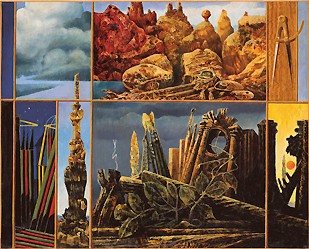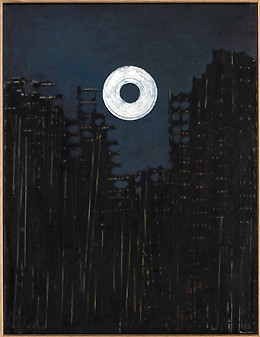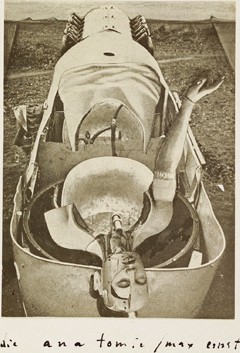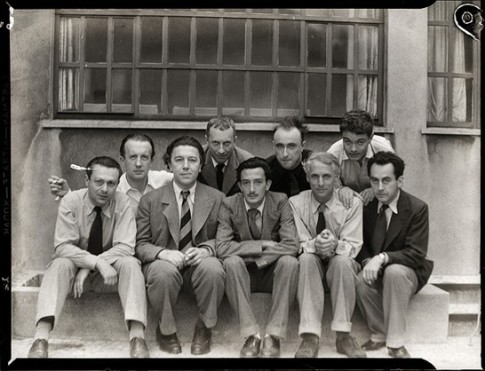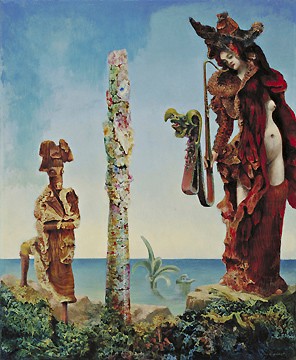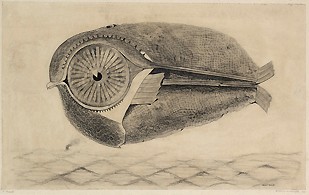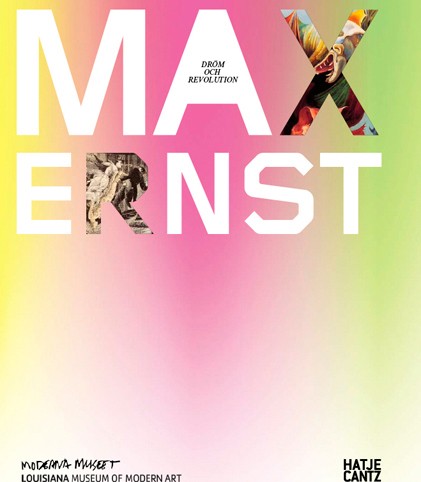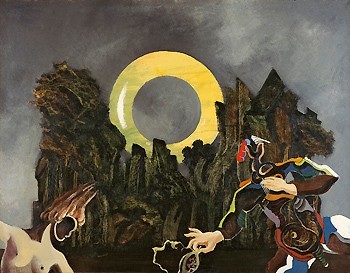
Max Ernst, Naissance d´une galaxie, 1969 © Max Ernst/BUS 2008. Beyeler Collection, Basel
Max Ernst in Europe: Coming Home and Late Recognition
Max Ernst moved back to Europe in 1953 and settled in France. At first, he lived in Paris, then in Huismes, Touraine, and finally in Seillans. His works from this period include Le printemps à Paris (Spring in Paris) and Vater Rhein (Father Rhine). The latter is an imaginary vision of a river god, combining cyclical nature, memories and legends, landscape and portrait. Ernst was awarded the grand prize for painting at the Venice Biennale in 1954. This had two consequences: his final exclusion from the surrealist group, but also international recognition that led to numerous solo exhibitions.
Graphic art gradually formed a large part of his production. The portfolio Maximiliana ou l’exercise illégal de l’astronomie (Maximiliana, or the Illegal Practice of Astronomy), dating from 1964, is a tribute to the forgotten 19th century German astronomer Ernst Wilhelm Leberecht Tempel who calculated the return of comets and discovered a large number of stars and the planet Maximiliana which the title refers to.

Max Ernst also intentionally returned to, extended and modified earlier themes, and added yet another facet to his œuvre. Using exact, straight or curved contours, he reduced his works into simple shapes and characterisations of his figures.
In his works from the late 1950s and onwards, Max Ernst focused on nature and the forces of life. The cosmic imagery approaches that which is most distant, the infinity of space. Max Ernst presents the seemingly simple yet complex galaxies, possible worlds and parallel worlds that lie beyond our wildest imagination.
1953–1976
1953
Dorothea Tanning and Max Ernst return to Europe for good and move to Paris. Works in the Impasse Ronsin (XVth Arrondissement) next to Constantin Brancusi’s studio. Travels in the fall to Heidelberg and Cologne. Vater Rhein, Le printemps à Paris.
1954
Max Ernst receives the Grand Prize for painting at the 27th Venice Biennale, Hans Arp for sculpture, and Joan Miró for printmaking. Max Ernst is again excluded from the Surrealist group by André Breton.
1955
Max Ernst moves with Dorothea Tanning to Huismes near Chinon in the Vienne River valley. Rock’n’ Ruin.
1956
Max Ernst is made a member of the Akademie der Künste in Berlin. Retrospective at the Kunsthalle Bern. Brings back Un peu de calme from his house in Saint-Martin-d’Ardèche and reworks its. Spends the winter with Dorothea Tanning in Sedona. A Maiden, a Widow and a Wife.
1957
Max Ernst receives the Grand Prize for Painting from the West German state of North Rhine-Westphalia. Les princes dorment mal.
1958
Max Ernst becomes a French citizen. The first comprehensive monograph by Patrick Waldberg is published. 33 fillettes chassant les papillons, Les corbeaux de bonne humeur.
1959
Large retrospective at the Musée National d’Art Moderne in Paris.
1960
Travels through Germany with Patrick Waldberg.
1961
Max Ernst receives the Stefan Lochner Medallion from the city of Cologne on the occasion of his 70th birthday. Designs the stage settings for Jean-Louis Barrault’s production of Judith at the Théâtre de l’Odéon, Paris. The costumes are made after designs by Dorothea Tanning. Visits the United States on the occasion of the retrospective at the Museum of Modern Art in New York. The exhibition is subsequently shown in Chicago (The Art Institute) and London (Tate Gallery).
1962
Spends the early part of the year in New York and travels to Greece in the summer. Retrospective at the Wallraf Richartz Museum in Cologne. The exhibition is later shown at the Kunsthaus in Zurich. Ci meurent les cardinaux.
1963
Spends the spring in Sedona. Peter Schamoni makes the film Entdeckungsfahrten ins Unbewußte about Max Ernst. Death of Tristan Tzara.
1964
Max Ernst and Dorothea Tanning settle in Seillans in the South of France. Awarded the Lichtwark Prize by the city of Hamburg. Made an honorary professor of the state of North Rhine-Westphalia. Publication of the book Maximiliana ou l’exercise illégal de l’astronomei, Le ciel épouse la terre.
1965
Peter Schamoni makes the film Mein Vagabundieren—meine Unruhe on the life of Max Ernst.
1966
Conferred with the Officer of the Legion of Honor. Exhibitions at the Jewish Museum in New York and the Palazzo Grassi in Venice. Max Ernst rejects the freedom of the city of Brühl. John Russell’s monograph Max Ernst: Life and Work is published.
1968
The construction of a new house in Seillans is started according to the plans made by Max Ernst and Dorothea Tanning. Max Ernst designs the stage settings of La Turangalîla at the Opéra National de Paris. Dedication of the fountain at Amboise. Le silence à travers les âges, Octobre.
1969
Visits Stuttgart and Tübingen. Retrospective at the Moderna Museet in Stockholm. Naissance d’une galaxie, Tangled Lightning.
1970
Exhibition at the Stedelijk Museum in Amsterdam, then at the Württembergischer Kunstverein, Stuttgart. Lewis Carrolls Wunderhorn is published with lithographs by Max Ernst. Gallimard publishes Écritures (writings from 1919 to 1969).
1971
Touring exhibition Das Innere Gesicht with works by Max Ernst from the collection of Jean and Dominique de Menil through France, Germany, and the United States. Travels to Düsseldorf in May for the dedication of the Habakuk statue and the fountain at Brühl with a subsequent ceremony celebrating his 80th birthday.
1972
Conferred with an honorary doctorate by the University of Bonn. Max Ernst illustrates and translates texts by Heinrich von Kleist, Clemens Brentano, and Achim von Arnim into French.
1973
Travels to Houston in February for the exhibition Inside the Sight.
1974
Max Ernst suffers a stroke.
1975
Travels to New York on the occasion on the large retrospective at the Solomon R. Guggenheim Museum which is subsequently shown in an enlarged form at the Grand Palais in Paris. The first two volumes of the catalogue raisonné (Spies/Leppien, Das graphische Werk, and Spies/Metken, Werke 1906–1925) are published in Cologne.
1976
Max Ernst dies in Paris on April 1 in the night before his 85th birthday and was buried at Père-Lachaise Cemetery.

